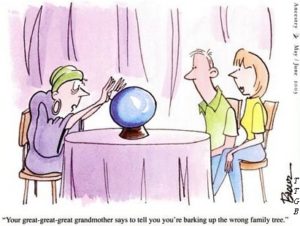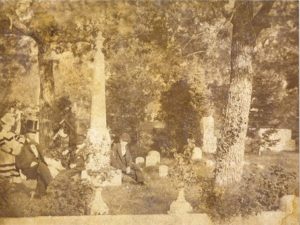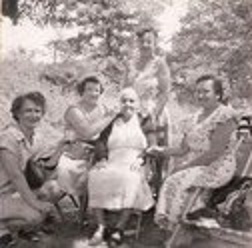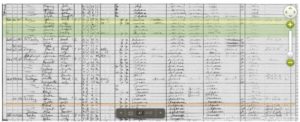Originally published on genealogyatheart.blogspot.com on 1 Nov 2015.
I’ve been blogging about synchronicity – those meaningful coincidences that occur – and genealogy. I’m going to blog about events that I cannot explain but held a powerful message to my immediate family and I. Here’s what happened.
First, a little background information. I am an only child and was extremely close to my mother. Today is All Saint’s Day, and although my mom won’t be canonized by the Roman Catholic Church, she’s the closest person I’ve ever known that espoused the characteristics of a saint. An uneducated, single mom at a time when the world did not look favorably on divorce, my mom always put my needs and wants above her own. A hard worker, she never complained about her lot in life and always spoke up for the underdog. Material things were of no interest to her. She preferred to be outside, enjoying nature, or reading a book. She especially loved butterflies and could spend hours watching them dance among the flowers.
In January of my 2nd grade I contracted rubella. I remember feeling hot, tired and itchy shortly after returning home from Sunday 9:30 AM Mass. Mom asked me what what wrong and I didn’t know; I just didn’t feel well. Mom and grandma decided I didn’t look well and needed to lay down. The next thing I remember was a few days later. I awoke and heard crying. I felt wonderful, better than I had ever felt. I was happy and light and filled with joy! The crying didn’t sadden me in the least but I was curious as to who was upset and why. It was my mother who was being hugged by my grandmother. They were standing in the hallway outside of my bedroom. My grandmother was speaking in Croatian, caressing my mother’s head and saying, “Doro, I’m so sorry. I know. Ssh Ssh. It’s in God’s hands.” What was in God’s hands? It was then that I realized I was a part from my body. I was somehow above my body, still in my bedroom but I was at the ceiling level and could see through the closed door. Looking around, I could see myself lying in bed, covered with a quilt. I wasn’t afraid. Instead, I was delighted that I was seeing from a different perspective. I discovered I could move by just thinking so I decided to explore. I moved so quickly, I call it zipping, that I soon found myself outside of my bedroom. I could see my school a block away. It was night and the stars were twinkling. There was snow on the ground and the trees were bare of leaves but I wasn’t cold. I tried to look at my hands and feet but could see nothing. I was invisible. Then, I saw a path of light. I felt drawn to it. As I came closer I noticed that there were many “stars”, little pinpricks of light that were also following along the lighted path. I joined them but was halted by a voice. The voice was kindly and although I call it a voice, there was no sound made. Rather, the words were understood without noise. The message I received asked if I was ready. I knew what that meant. Was I ready to move from this life to the next. I wanted to badly because I felt so wonderful BUT I could still hear my mother crying. My mental reply was that I couldn’t go forward as that choice would destroy her. Instantly, I found myself back in bed with a thud. I was heavy and hot and congested and itchy and miserable. I regretted my decision. I cried out and my mother and grandmother rushed in the room. They helped me sit up and brought me a cold glass of water.
Unbeknownst to me, I had been in a coma for several hours. A classmate who’s dad was a doctor lived down the street. Dr. Lorenty had been summoned to check on me and had left moments before I “awoke.” He had told my mother that there was nothing he could do and to prepare for my death. After my decision to live I made a quick recovery. So quick, in fact, that my regular physician, Dr. Fadell, called it miraculous. I knew it was no miracle; I was being prepared for First Communion so I considered to be an example of free will. I had survived because I chose to do so.
The problem was no one would listen to what I experienced. When I first told my mom I chose to live because she was so upset she looked aghast. She asked me to never talk about my experience again. My grandmother was the one who told me about the physician visit. Grandma also said to not mention what happened as people wouldn’t understand. I did as they requested and only my husband and children knew the story, until today.
Because of that experience I have never feared death.
Unfortunately, my great grandmother, maternal grandmother, paternal grandfather, several aunts, mother and father experienced extremely slow deaths from Alzheimer’s. For those of you that have had a loved one touched by that horrible disease you understand why I say it’s a slow death. Each of the individuals I mentioned was ravaged in a different way. My great grandmother became childlike. She would coo to my dolls believing they were her children. My grandmother talked to pictures and the television, insisting they were communicating directly to her. My father and a maternal aunt stopped communicating entirely. My mother, however, fought the disease until the end. She volunteered to take part in a University of South Florida study as she wanted researchers to discover an effective treatment so other families wouldn’t have to go through the hardship. The double blind study did not allow us to know if the experimental drug mom received was a placebo or not. We learned at the study’s conclusion that she had been given an early version of Aricept. Not a cure, it did allow her to probably live independently longer than she would have. I say probably because one can never know for sure but that view is in comparison to all the other family members who had not been given the medication.
When Mom broke her hip and was confined to a wheel chair she showed my kids how she had learned to pop wheelies. She always knew who the immediate family was but she had difficulty in knowing who was living and who wasn’t. She insisted her deceased sister and mother had visited the night before and she would relay their messages to us. We would kid her that what she needed to let us know were the lotto numbers so we could win. She did not find that amusing. Instead, she always said she would send a message via butterfly that she was fine after her death.
When she lost the ability to swallow I wished that she would make the choice to end the suffering. Shortly after the terrible events of September 11th, mom passed away.
The Sunday after my mother’s death I told my family that I wanted to take a long walk on the beach. My mother loved Honeymoon Isle so that is where I headed. This is what I wrote after I returned home from the beach:
“On Sunday, October 7, 2001 I decided to take my walk on Honeymoon Island Beach early in the day as [my family] and I had decided to have a family memorial service for my mother in the afternoon, followed by a lamb dinner at Hella’s Restaurant in Tarpon Springs, FL, as lamb was always a traditional food used in the family during times of celebration. Although we were greatly saddened at the loss of mom/grandma, we were rejoicing that her invalid condition was over as she was of independent spirit during most of her lifetime and she hated being confined to a wheelchair.
I often walk the 2 miles to the island point and the 2 miles back as quickly as I can for aerobic exercise and I enjoy the walk solo as others in the family have difficulty in maintaining my pace. I also enjoy the solitude of the beach as the area is often deserted. This Sunday morning I left the house shortly after 9 AM with my pedometer on, ready for a brisk walk in the cool morning air.
The beach was more populated than usual but most people were elderly, using canes or each other for support and congregating near the bath house. In 4 minutes, I had walked a quarter of a mile, leaving most of the people behind me. It was near the quarter mile mark when I first noticed a yellow carnation. With each few steps I encountered more and more flowers – all varieties and colors – roses, mums, daisies – in yellows, pinks, reds and whites. My initial thought was that someone had had a wedding on the beach the day before but I soon dismissed that as I noticed that the flowers must have come ashore from the gulf as they were wrapped in sea grass. The thought that crossed my mind was that someone must have had a wonderful party on a ship the evening before but the flowers were so fresh that I dismissed this, too. They were not onshore in clumps, either, but strewn almost an equal distance apart and alternating in type and color. By the 3/4 marker the oppressive fragrance of roses overcame me. I looked around to try to find the source. Nothing close by was blooming, only the sea oats which had gone to seed bent their heads in the wind. I could find no source for the odor which permeated and seemed to follow me as I walked. It reminded me of the smell that we would occasionally come across in our last house. That, too, had never been explained but it always seemed to follow a crisis of some sort and soon after, better times returned. This led me to think about my mother and I thought that perhaps I was mistaken in calling the cemetery [up north] and that maybe I should have my mother’s ashes spread in the gulf as she had mentioned once. I thought that the flowers might be from a ceremony of that type.
At the one mile marker I noticed the only yellow rose. Being my favorite flower, it made me smile. When I looked up I caught a glimpse of something flying over the water out of the corner of my left eye. At first I thought it was a sandpiper but as it flew I realized that it had a different movement. That’s when I realized it was a butterfly – a huge brown and reddish colored butterfly the likes of which I had never seen. I stopped immediately and thought that I was hallucinating. My mother loved butterflies, the beach, flowers, and me. All of a sudden the symbolism struck me. I took out my cell phone and called [my husband] because I couldn’t believe I was really seeing these things. The number was busy. I tried again, it was still busy. I decided he must be surfing the net. (This was the days of dial up connections) It was then that I realized that the butterfly hadn’t moved forward but was merely fluttering up and down over the waves. I said, “Mom?” and with that the butterfly moved towards me on the beach a little but continued north. I followed. The sky became dark, thunderheads mushroomed in the north and west. The waves and wind increased in strength. I spoke to the butterfly of things that had remained unsaid. At one point it came onto the beach and I again stopped. I reached out my hand but it remained just out of reach. I followed the butterfly almost to the end of the island where it crossed the small strip of sand and headed towards the bay. The sky had become even more turbulent and I feared that I wouldn’t make it back to the car safely. Even so, I stood transfixed, I couldn’t let the sight of the butterfly go just yet. The butterfly flew off across the bay. The sky in the east was bright blue and the morning sun glinted off the crest of the waves, leaving dancing lights. I watched until I saw the butterfly dip down into one wave and become a spark of light. I let out a cry, knowing that I would never see the butterfly again. I looked at my watch. 15 minutes had passed from beginning to end. I began to walk back to the car. As soon as I crossed the small slip of land to walk back along the water’s edge I came across a whole shell. It was the type that my mother often collected and prized – a large clam shell, opened but still intact. I reached down and picked it up.
When I reached the 1 mile mark I picked up the yellow rose as proof of what had happened. It was too unbelievable and I wanted to have something tangible to show. Stranger still, was that every flower was gone upon my return – only 4 remained – all yellow, my mother’s favorite color – and strewn at each of the remaining mile markers (3/4, 1/2 and 1/4). Next was a mum, the type of flower my mother used to buy for [my husband] occasionally as she felt it was appropriate for a man. Someone [although there didn’t appear to be anyone else on the beach ahead of me] had stuck it standing straight up in my path. At first I passed it, leaving it as it had begun to drizzle but something insisted that I retrieve it so I went back about 20 steps and collected it. Then I came upon the first and second carnations, the flowers she sometimes bought for the kids. I stopped and picked them up, too. Stems, leaves and an occasional petal remained of the other flowers but nothing more. It began to pour by the time I reached the last flower. I walked back to the car and really don’t remember much of anything as I think I was in shock. I came home, [my husband] made me a cup of hot British tea and I related what had transpired.
Later that afternoon, on our drive to Hella’s [Restaurant], we were a few blocks from the sponge docks and [my husband] mentioned the fact that in all the years we have lived in Florida and as frequently as we go to the beach (almost daily in the summer and at least 2-3 times during the rest of the year), we have never seen a butterfly on the gulf, nor come across flowers strewn as they had [been that morning]. Usually you come across the remains of a bouquet still intact but nothing of this magnitude and never with the strong odor that had come, too. Just then, out of right side in front of the car a monarch butterfly flew. We all saw it and I said, “Look at the monarch.” Instantly it disappeared. We have no explanation for any of these events. Lori Samuelson 10-8-01″
Although these occurrences are odd, another strange encounter was yet to happen.
My mother had prearranged to be cremated but she had never decided on what to do with her cremains. Whenever I’d ask the response was, “Whatever you like.” Once she mentioned being scattered in the gulf but another time she mentioned being interred in the family plot in Indiana. After the beach event I was torn about what to do. I decided to go with the cemetery and arranged for the cremains to be interred during our winter break from school. It was my daughter’s senior year and as she had taken days off to visit colleges, she had no more excused absences available. We drove to northern Indiana on Christmas Day with mom in the trunk. The Memorial Service was to be held the morning of the 26th. When we arrived at Oak Hill Cemetery in Gary, Indiana we were told that a snowstorm was forecast and that the ground might be too hard for the internment. I was devastated. Maybe mom didn’t want to be buried. Maybe I should just take her ashes back to Florida. The clerk told us to wait inside the office and she’s speak with the workers. There were only 2 chairs in the office so I sunk into one. I was sadly staring at the floor when I heard my daughter say, “Look, it’s grandma.” Looking up, I saw a monarch butterfly soar across the counter and land on my daughter’s arm. I burst into tears. My husband said, “Amazing.” A moment later the clerk returned and said that the workman were able to dig the hole and we were ready to begin the interment. The clerk looked at my tears and smiled. I couldn’t find words to explain that the tears weren’t of sadness but of knowing that my mom was okay and that the decision I made was fine. My husband tried to explain. The clerk said that once in awhile butterflies just show up in the office, probably came in with flowers. That may be but a monarch in northern Indiana in late December will always be seen by me as a final message from my mom.



































